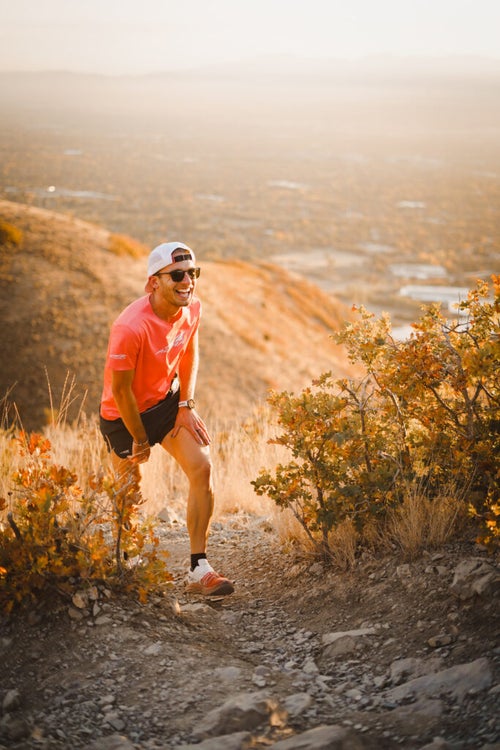New perk! Get after it with local recommendations just for you. Discover nearby events, routes out your door, and hidden gems when you sign up for the Local Running Drop.
We are currently in an era of abundant information and easily accessible data at our fingertips.
“It’s very easy to get caught up in new technologies and training log data,” said elite ultrarunner Ryan Montgomery. The 28-year-old Utah runner’s accomplishments include numerous podium finishes over the past seven years, including Tarawera Ultramarathon, Javelina Jundred, and Tahoe 200 Endurance Run. While incorporating new information into your running practice can be valuable for insights into fatigue or gait metrics, it is important not to lose sight of the technology’s purpose.
“It’s easy to get caught up in that [technology] and forget your ‘why statement’ in running,” said Montgomery. “If you ask the question, ‘Tell me one of your first experiences trail running, or the first time you fell in love with running, where you almost forgot your running and felt like you were in that flow state?’ Most of the time, technology is not part of that story.” Here, he references the inclination for many to become hyper-focused on pace, heart rate monitors, music, and other data inputs.

Montgomery’s ‘Why’ in Running
Montgomery’s ‘why’ began in middle school when he was living on the western coast of Prince of Wales Island in the small fishing community of Craig, Alaska. “I had just moved from the Seattle suburbs to Alaska, a town of 1,000 people,” Montgomery explained. “I used to go on this dirt trail by my house, down by the water. I would be among all these birds, and the water would hit the shore. I felt very just connected to my body, nature, and the environment around me.”
He continues to pull energy from that day. Being a trail runner, he looks for that same connection every time he goes out the door. “I fill up that cup in all the different contexts I’m in, whether on a mountain or the road. I’m trying to find that connected experience to my environment,” he said. “That being said, I have to be very thoughtful and check in with myself about how I use that energy and connection to my ‘why’ almost every week.”
This can be especially challenging with the plethora of distractions.
“If you’re one of those people who’s always grabbing your phone, you might be very tempted to be distracted all the time,” he said. “For those people, maybe you have to build safeguards and create boundaries.”
It might be helpful to create boundaries where you only allow yourself to have an open screen on your watch for half of your runs each week, or perhaps, put your watch in your pocket to continue collecting data, but not look at it.
“You have to find those safeguards for yourself, but only after you do an internal introspective evaluation of the type of runner you are,” Montgomery said. “Am I good at connecting with my ‘why?’ Or do I find myself heavily indexed in the data and technology?”
RELATED: Adventure: Simplified
Some of the social aspects of running may be that taking away from that ‘why’ experience by running each day. “From there, I think you can make those decisions for how I get back to those basics.”
Running Thought Experiment
Montgomery proposed an introspective exercise to help individuals measure their attachments to devices and manage a healthier relationship with technology.
“Are [you] someone who always listens to music every time you run, no matter what environment you are in, what do you feel like you’re missing out on? Do you find yourself, the moment you finish your run, pulling up your app to sync to your watch and then putting it on Strava?”
This reflective activity can help you challenge your current behaviors and ask yourself, “You know what? I run with headphones every time, and I don’t know why I do that. Maybe it’s because I’m looking for a distraction, and maybe if I didn’t, that would give me a new experience I’ve never had before.”
Running can be as simple or as complex as you want it to be.
“I think the biggest lesson I’ve learned in my lifetime of running is just listening to your body and trusting it,” said Montgomery. “Your body will tell you what it wants and needs.”
With experience, each runner will learn to develop trust in their body’s signals. These signals provide clues as to how to make adjustments to each run. “I allowed that flexibility in my schedule because my ‘why’ is I want to be in beautiful places, and the [foliage] colors are prime right now.”
When Montgomery is running, he’s constantly checking in with how he’s feeling and how his legs and breathing are doing.
“I approach running as an opportunity to learn about my body and my relationship with my body in a feedback loop,” Montgomery explains. “Sometimes, when you overstimulate your runs with music and data, you’ll notice how it desensitizes that feedback loop with your body.”
Developing this relationship is key to longevity in the sport, he believes.
“I think that is so important as a runner for sustainability and how it better connects you to your environment,” Montgomery explains. “When you feel like you’re just so connected to your body, you’re also connected with your surroundings at the same time. I think they’re interchangeable, like those relationships you’re developing. But when you’re developing a relationship with something that is artificial, then you kind of sever that connection with both.”
RELATED: Unlocking the “Why”: The Science Behind What Motivates Ultrarunners
Ben Pryor (Choctaw) is a contributing writer for several national and regional publications, including Native News Online and Indian Country Today. He has graduate degrees in Political Science (American Politics) and Philosophy (Philosophy of Language). His writing interests include running, politics, and the environment.
